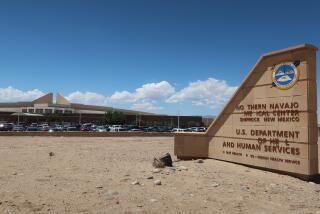Navajo Steel Gangs Holding Onto Culture as They Lay Rail Tracks
- Share via
FRESNO — Stepping over rusted spikes freshly pulled from the ground, workers on a nomadic Navajo Indian crew lay another stretch of track just as their people have done for decades.
“The pay is good and you get to see the country,” said Raymond Yazzie, a second-generation rail spiker who has laid hundreds of miles of track for the Santa Fe Railway. “And it’s not so hard on your back now--it used to be hard work in the old days when my father started.”
Navajo steel or track gangs have spent years perfecting the modern art of track laying, said Vern Colbert, a Santa Fe supervisor.
“That’s all these guys do, year-round,” he said. “This is about the fifth gang I’ve worked with, and, oh, it’s quality work--they’ve passed these skills down from father to son.”
The hundreds of Navajos who work for Santa Fe and other railroads have become a tradition since they first were hired off the reservation in the 1950s, said Ed Trandahl, a spokesman for Union Pacific Railroad.
“They’re on the road a lot, and it’s not easy work pounding in spikes and lifting plates, but they have a very good work ethic and they kind of stick together,” he said.
Hundreds of Navajos will work for Union Pacific to help complete its $250-million rail project from Wyoming to Kansas City, he said.
Santa Fe employs 225 Navajo workers, and more are eager to join, said J.B. Collyer, who has been hiring Navajo steel gangs since 1967. However, budget cutbacks have eliminated several projects this year, reducing the amount of time the crews have worked.
“They’d like to work year-round like everybody else, but most have been around the railroad long enough to know every day’s a new day,” said Collyer, former owner of a Navajo reservation trading post. “Unemployment is very high on the reservation and they’re always very eager to get on.”
When a job comes up, Collyer uses a roster to fill a team. The chosen group meets in Gallup, N.M., then travels by bus to the job site for anywhere from a few weeks to months.
“They’ll step off the bus in any city, and you don’t even have to tell them what to do,” Collyer said.
Yazzie, a 15-year veteran, mans one of a dozen computerized rigs that replace the railway’s old tracks. Others on either side of the tracks help pull and sort spikes, fuse the rail and check its safety before the next freight train rumbles by.
For Yazzie and many of the 85 other Navajos on the three-week Fresno job, the next stop was Barstow, more than 200 miles away.
The bookkeeper on the Fresno project said the nomadic steel gangs need little supervision on their jobs from Chicago to Los Angeles.
“When it comes to laying steel, we’re the professionals. We’re the best,” said Nathan, who refused to give his last name.
Traditional braided hair was partly hidden beneath workers’ helmets, and a cluster of men spoke in native Navajo tongue.
“All of us speak Navajo, and we still have respect for our culture,” Nathan said. “In my land we have to hold on to what’s left.”
More to Read
Sign up for Essential California
The most important California stories and recommendations in your inbox every morning.
You may occasionally receive promotional content from the Los Angeles Times.













